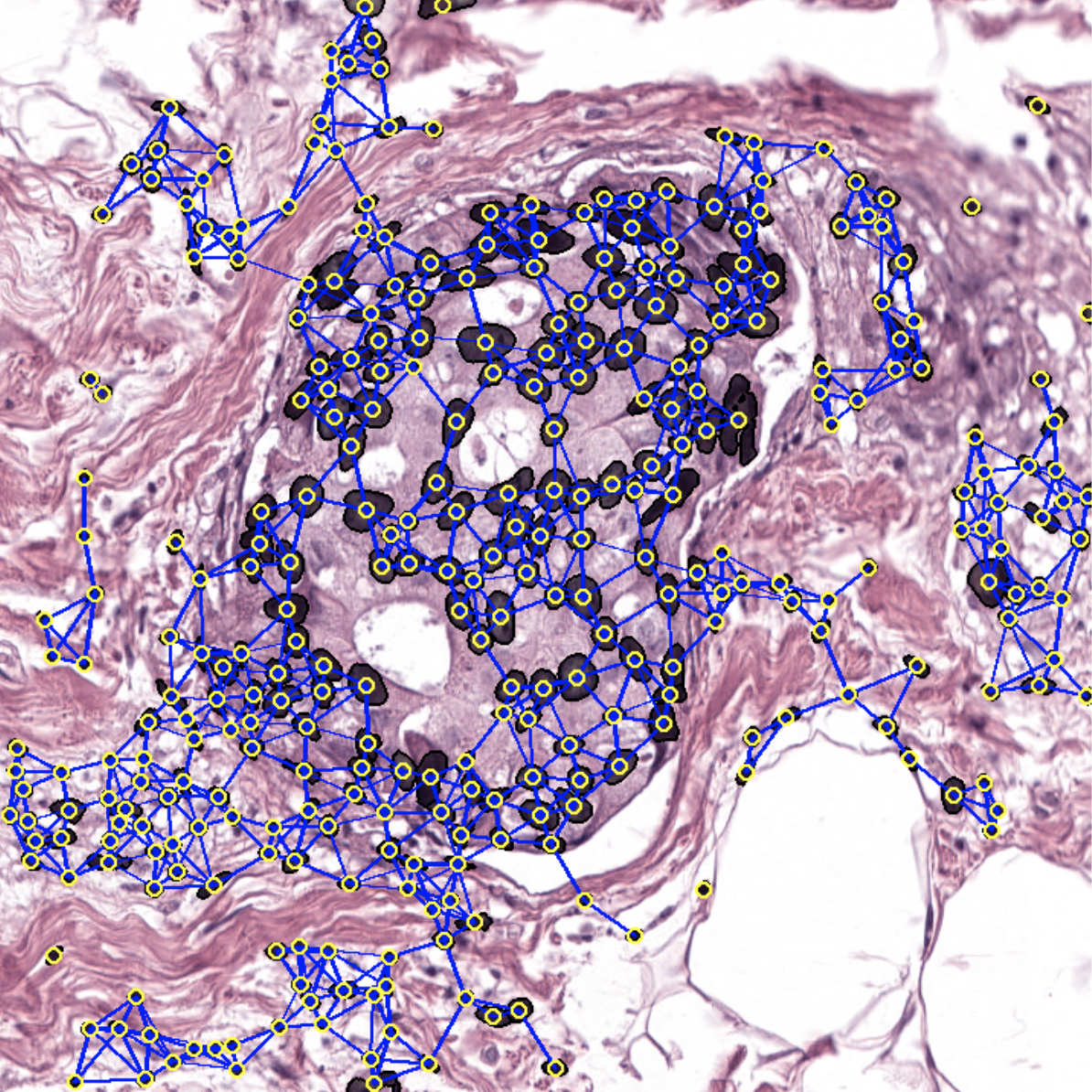https://github.com/biomedsciai/histocartography
A standardized Python API with necessary preprocessing, machine learning and explainability tools to facilitate graph-analytics in computational pathology.
https://github.com/biomedsciai/histocartography
deep-learning graph-neural-networks healthcare machine-learning pathology pytorch
Last synced: 7 months ago
JSON representation
A standardized Python API with necessary preprocessing, machine learning and explainability tools to facilitate graph-analytics in computational pathology.
- Host: GitHub
- URL: https://github.com/biomedsciai/histocartography
- Owner: BiomedSciAI
- License: agpl-3.0
- Created: 2019-11-27T10:10:55.000Z (almost 6 years ago)
- Default Branch: main
- Last Pushed: 2023-12-23T15:08:07.000Z (almost 2 years ago)
- Last Synced: 2025-03-30T13:08:26.744Z (8 months ago)
- Topics: deep-learning, graph-neural-networks, healthcare, machine-learning, pathology, pytorch
- Language: Python
- Homepage:
- Size: 177 MB
- Stars: 251
- Watchers: 5
- Forks: 58
- Open Issues: 22
-
Metadata Files:
- Readme: README.md
- License: LICENSE
Awesome Lists containing this project
README

[](https://travis-ci.com/histocartography/histocartography)
[](https://codecov.io/gh/histocartography/histocartography)
[](https://badge.fury.io/py/histocartography)

[](https://pepy.tech/project/histocartography)
**[Documentation](https://biomedsciai.github.io/histocartography/)**
| **[Paper](https://arxiv.org/pdf/2107.10073.pdf)**
**Welcome to the `histocartography` repository!** `histocartography` is a python-based library designed to facilitate the development of graph-based computational pathology pipelines. The library includes plug-and-play modules to perform,
- standard histology image pre-processing (e.g., *stain normalization*, *nuclei detection*, *tissue detection*)
- entity-graph representation building (e.g. *cell graph*, *tissue graph*, *hierarchical graph*)
- modeling Graph Neural Networks (e.g. *GIN*, *PNA*)
- feature attribution based graph interpretability techniques (e.g. *GraphGradCAM*, *GraphGradCAM++*, *GNNExplainer*)
- visualization tools
All the functionalities are grouped under a user-friendly API.
If you encounter any issue or have questions regarding the library, feel free to [open a GitHub issue](add_link). We'll do our best to address it.
# Installation
## PyPI installer (recommended)
`pip install histocartography`
## Development setup
- Clone the repo:
```
git clone https://github.com/histocartography/histocartography.git && cd histocartography
```
- Create a conda environment:
```
conda env create -f environment.yml
```
**NOTE**: To use GPUs, install GPU compatible [Pytorch](https://pytorch.org/get-started/locally/), [Torchvision](https://pytorch.org/get-started/locally/) and [DGL](https://www.dgl.ai/pages/start.html) packages according to your OS, package manager, and CUDA.
- Activate it:
```
conda activate histocartography
```
- Add `histocartography` to your python path:
```
export PYTHONPATH="/histocartography:$PYTHONPATH"
```
## Tests
To ensure proper installation, run unit tests as:
```sh
python -m unittest discover -s test -p "test_*" -v
```
Running tests on cpu can take up to 20mn.
# Using histocartography
The `histocartography` library provides a set of helpers grouped in different modules, namely `preprocessing`, `ml`, `visualization` and `interpretability`.
For instance, in `histocartography.preprocessing`, building a cell-graph from an H&E image is as simple as:
```
>> from histocartography.preprocessing import NucleiExtractor, DeepFeatureExtractor, KNNGraphBuilder
>>
>> nuclei_detector = NucleiExtractor()
>> feature_extractor = DeepFeatureExtractor(architecture='resnet34', patch_size=72)
>> knn_graph_builder = KNNGraphBuilder(k=5, thresh=50, add_loc_feats=True)
>>
>> image = np.array(Image.open('docs/_static/283_dcis_4.png'))
>> nuclei_map, _ = nuclei_detector.process(image)
>> features = feature_extractor.process(image, nuclei_map)
>> cell_graph = knn_graph_builder.process(nuclei_map, features)
```
The output can be then visualized with:
```
>> from histocartography.visualization import OverlayGraphVisualization, InstanceImageVisualization
>> visualizer = OverlayGraphVisualization(
... instance_visualizer=InstanceImageVisualization(
... instance_style="filled+outline"
... )
... )
>> viz_cg = visualizer.process(
... canvas=image,
... graph=cell_graph,
... instance_map=nuclei_map
... )
>> viz_cg.show()
```

A list of examples to discover the capabilities of the `histocartography` library is provided in `examples`. The examples will show you how to perform:
- **stain normalization** with Vahadane or Macenko algorithm
- **cell graph generation** to transform an H&E image into a graph-based representation where nodes encode nuclei and edges nuclei-nuclei interactions. It includes: nuclei detection based on HoverNet pretrained on PanNuke dataset, deep feature extraction and kNN graph building.
- **tissue graph generation** to transform an H&E image into a graph-based representation where nodes encode tissue regions and edges tissue-to-tissue interactions. It includes: tissue detection based on superpixels, deep feature extraction and RAG graph building.
- **feature cube extraction** to extract deep representations of individual patches depicting the image
- **cell graph explainer** to generate an explanation to highlight salient nodes. It includes inference on a pretrained CG-GNN model followed by GraphGradCAM explainer.
A tutorial with detailed descriptions and visualizations of some of the main functionalities is provided [here](https://github.com/maragraziani/interpretAI_DigiPath/blob/feature/handson2%2Fpus/hands-on-session-2/hands-on-session-2.ipynb) as a notebook.
# External Ressources
## Learn more about GNNs
- We have prepared a gentle introduction to Graph Neural Networks. In this tutorial, you can find [slides](https://github.com/guillaumejaume/tuto-dl-on-graphs/blob/main/slides/ml-on-graphs-tutorial.pptx), [notebooks](https://github.com/guillaumejaume/tuto-dl-on-graphs/tree/main/notebooks) and a set of [reference papers](https://github.com/guillaumejaume/tuto-dl-on-graphs).
- For those of you interested in exploring Graph Neural Networks in depth, please refer to [this content](https://github.com/guillaumejaume/graph-neural-networks-roadmap) or [this one](https://github.com/thunlp/GNNPapers).
## Papers already using this library
- Hierarchical Graph Representations for Digital Pathology, Pati et al., Medical Image Analysis, 2021. [[pdf]](https://arxiv.org/abs/2102.11057) [[code]](https://github.com/histocartography/hact-net)
- Quantifying Explainers of Graph Neural Networks in Computational Pathology, Jaume et al., CVPR, 2021. [[pdf]](https://openaccess.thecvf.com/content/CVPR2021/papers/Jaume_Quantifying_Explainers_of_Graph_Neural_Networks_in_Computational_Pathology_CVPR_2021_paper.pdf) [[code]](https://github.com/histocartography/patho-quant-explainer)
- Learning Whole-Slide Segmentation from Inexact and Incomplete Labels using Tissue Graphs, Anklin et al., MICCAI, 2021. [[pdf]](https://arxiv.org/abs/2103.03129) [[code]](https://github.com/histocartography/seg-gini)
If you use this library, please consider citing:
```
@inproceedings{jaume2021,
title = {HistoCartography: A Toolkit for Graph Analytics in Digital Pathology},
author = {Guillaume Jaume, Pushpak Pati, Valentin Anklin, Antonio Foncubierta, Maria Gabrani},
booktitle={MICCAI Workshop on Computational Pathology},
pages={117--128},
year = {2021}
}
@inproceedings{pati2021,
title = {Hierarchical Graph Representations for Digital Pathology},
author = {Pushpak Pati, Guillaume Jaume, Antonio Foncubierta, Florinda Feroce, Anna Maria Anniciello, Giosuè Scognamiglio, Nadia Brancati, Maryse Fiche, Estelle Dubruc, Daniel Riccio, Maurizio Di Bonito, Giuseppe De Pietro, Gerardo Botti, Jean-Philippe Thiran, Maria Frucci, Orcun Goksel, Maria Gabrani},
booktitle = {Medical Image Analysis (MedIA)},
volume={75},
pages={102264},
year = {2021}
}
```